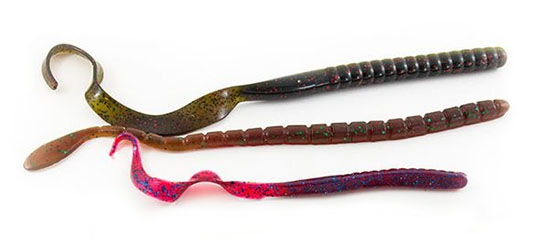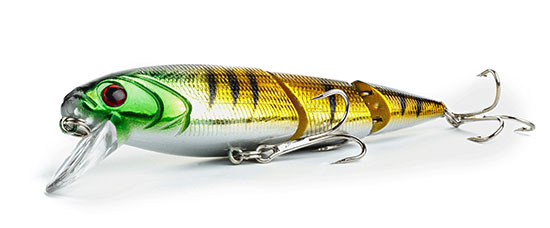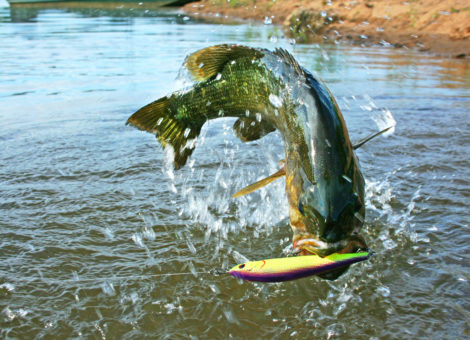When fishing for largemouth bass, the lure you choose is extremely important. But with the wide range of bass fishing lures out there, choosing one can be a bit overwhelming. Walk into any large tackle store and you’ll be bombarded with a huge selection of lures in different sizes, shapes, colors and scents. Which is the best one to use? The answer is “it depends.”
There really is no perfect lure for largemouth bass. You can catch a fish with all of them in the right conditions. So how do you decide which one to buy? The best lure will depend on your specific situation. So, before you choose, think about the specific circumstances of your fishing adventure and choose accordingly.
The Lure Selection Process
Let’s start with the fundamentals. When choosing a lure, consider everything about the location in which you plan to fish. Ask yourself the following questions:
- What’s the water temperature like?
- How deep is the water?
- Is the water clear or cloudy?
- Do you plan to fish near a structure?
- Are you planning to fish in the fall, winter, spring or summer?
- Which presentation technique do you plan to use?
All of these things should factor into your decision. By answering these questions, you can determine which colors, sizes and other features will work best in your specific situation.
Your best bet is to start by deciding which category of lure you want to use. The different categories of bass lures include crankbaits, jigs, soft plastic fishing lures, spinnerbaits, spoons and topwater lures. Each has its own purpose and strength, which we’ll go over in this guide. Once you figure out the category, you’ll have a much easier time narrowing your search down to a specific lure. In the end, the lure you choose will be the best one for your particular fishing scenario – with a little personal preference thrown in.
The Big Four Largemouth Bass Lures
Generally, you want to stick with one of the four most popular types of lures. Known as “The Big Four”, these are spinnerbaits, plastic worms, crankbaits and jigs. These lures are popular for a reason – because they work. Let’s go over each one to figure out the best time to use them.
| Lure | Recommended usage and specs |
|---|---|
| Spinnerbaits |
|
| Plastic Worms |
|
| Crankbaits |
|
| Jigs |
|
1. Spinnerbaits
Spinnerbaits are great because you can use them in many different situations to catch many different types of fish – especially big largemouth bass. Spinnerbaits are known as “quiet” lures, which studies have shown work best for catching the smarter, bigger bass because they imitate the fish’s natural prey.

They’re also perfect because they work well in the largemouth bass’s natural habitat – shallow water with a lot of cover. If you plan to fish in an area like this, you can’t go wrong with spinnerbaits. These versatile lures will serve you especially well in places where other lures would snag, such as in thick water grass or near obstacles.
When to Use Spinnerbaits
These lures are so versatile that you can really use them all year long. There aren’t many situations where I haven’t had success getting a largemouth on my line using a quality spinnerbait.
Spinnerbaits do tend to be the go-to lure for certain situations and fishing conditions. The follow are a few times when spinnerbaits really shine.
- Windy days: When its windy the water surface gets a bit choppy and creates less light penetration and visibility. This makes it more difficult for bass to decipher between an artificial spinnerbait and real bait. This means more bites.
- Shad spawn: Find a shad spawn and you’ll find bass. Spinnerbaits do a great job mimicing shad with their flashing blades. Spinnerbaits are effective for bass fishing shad schools in open water, shoreline grass and anywhere else you find shad spawn.
- Fall: As winter approaches, baitfish begin moving from lakes to inlets and into creeks with bass in close pursuit. Run a spinnerbait through the mouth of an inlet or creek and you’ll up your chances of catching a bass.
- Murky muddy water: When visibility is low bass tend to rely on their other senses—like their lateral lines—to detect baitfish. When water is murky, spinnerbait blades emanate vibration like echo location that bass hone in on.
- Night time: Decreased light means decreased visibility. Spinnerbait motion draws in bass when visibility is low. On dark nights try spinnerbait with larger blades. When the moon is out, a bait with smaller blades works.
- Cover: Spinnerbaits work great for fishing in areas with lily pads, stumps, logs, pilings, and other hard structure. These baits are designed to deflect off cover. When they deflect they product a “shimmy” motion that attracts bass.
- Bass spawn: Wake a spinnerbait in spawning areas where bass are hold up creating and protecting their beds. This is a sure fire way to provoke a strike and catch big bass.
Where and How to Use Spinnerbaits
Use spinnerbaits in the following situations:
- Grass: Cast your bait out past an opening. Roll your bait over the grass and let it fall into the opening and sink to the bottom, then jig it up a few feet to catch the attention of the fish.
- Standing Timber: Reel your line in slowly while bumping the limbs.
- Deep Structure: Choose a large spinnerbait with a Colorado blade and reel it in just fast enough to make the blade spin.
- Ledges: Fish the entire ledge. Start at the top, then go all the way down the side of the ledge to the very bottom.
- Fallen Trees/Stump Fields: Cast out past an individual stump and bump the stump as you reel your line in.
- Grassy Areas: Reel your lure in slowly so it rolls over the grass.
- Deep Water: Choose a lure with an Indiana-style blade to give it lift.
General Tips for Using Spinnerbaits
- Use a larger spinnerbait if the weather is cold and reel it in slowly.
- Select a brightly colored or fluorescent lure if the water is murky. Choose a smaller, natural-colored lure if the water is clear.
- Reel your line in slowly if you’re dealing with slow fish. But if the fish are active, reel it in quickly.
- Use a smaller lure when fishing in the spring.
- As soon as you feel a hesitation or movement in your line, set the hook and catch your fish!
Pro Tip: For stained water I like to use a 1/2oz spinnerbait with a solid skirt and tandem gold-silver blades on 20 lbs fluoro test using a highspeed reel. If water clarity is high, use a similar spinnerbait but with a double wheel leaf and a more transparent skirt. Using a 1/2oz weight versus something heavier lets you keep the spinnerbait moving and creating some action in the water. These are best fished a foot to 2 feet from the surface.
2. Plastic Worms
You’d think it’d be easy to choose a plastic worm. After all, how many different types of worms can there be? You’d be surprised. The sheer variety of worms will make your head spin. But once you narrow it down, you’ll find that worms are probably the best lures to use for largemouth bass in warmer waters. Sure, you can use other plastics, like lizards or flukes, but when it comes to the largemouth bass, the worm is king.

When to Use Plastic Worm Lures
Plastic worms work great almost any time of the year, but there are a few exceptions. If the fish are especially active, you’ll want to opt for a faster lure, like a crankbait or spinnerbait. And if you’re fishing in winter, you don’t want to use worms because they’ll sink.
Where and How to Use Plastic Worms
One of the best things about using a plastic worm is the ability to catch largemouth bass in a variety of locations. Depending on where you fish, you’ll want to use different types of rigs for your plastic worms.
Use plastic worms in the following situations:
- Vertical Structures: Cast your worm so it lands near the wall, letting it drop to the bottom. Then, lift it about 6-8” and shake it. Keep doing this every few minutes until your line reaches the boat.
- Deep Brush Piles: Use a worm that has a flat tail. You want to stay away from curly-tailed worms because they can easily get tangled.
- Grass: Pick a straight-tailed, heavier worm and use a Texas rig so you can break through the top of the grass without snagging.
- Deep Structures: Choose an 8-10” worm and use a Carolina rig, or choose a 3-5” worm and try drop shotting it.
- Stump Fields: Rig your worm in the Texas or Carolina style.
- Clear Water: Choose a worm with an action tail. Since the fish will have good visibility, you want something that catches their attention.
General Tips for Using Plastic Worms
- Lift and drop your worm until your line gets back to the boat, then repeat. Never reel in a worm.
- Go slow – real worms don’t move fast, and neither should you.
- Give floating worms a shot if you want to try something different.
- Choose longer worms for murky water and active fish. Choose shorter worms for clear water and slow fish.
- Use worms when the water is at least 55° – this is when they work best.
3. Crankbaits
If you’re trying to figure out where the bass are hiding in a big body of water, the crankbait is your best option. These versatile lures allow you to cover a lot of water quickly. They come in many different sizes, weights, shapes and running depths, so choose wisely.

Even though crankbaits are great for catching largemouth bass, they can be difficult for beginners to use correctly. Therefore, you may want to wait until you’re a little more skilled before giving them a try. The reason is simple – they can get hung up easily. Though a great choice when fishing in thick cover, you have to be prepared to lose a few. But once you realize how effective they are, you’ll be willing to risk losing a few to catch that perfect fish.
Where and How to Use Crankbaits
You can use crankbaits in almost any fishing scenario. You just want to make sure you’re using the right one for the job. There are lipless versions that you can use anywhere, but you may want to choose one specifically for the depth of the water you’re fishing in.
If the water is more than eight feet deep, choose one specifically designed for diving deep. Use a shallow crankbait for anything less than five feet deep. And pick a medium-depth crankbait for anything in-between.
Use crankbaits in the following situations:
- Ledges or Drops: Let your crankbait bump along the structure’s features.
- Stump Fields: Bounce your crankbait off of the stumps. This movement will catch the eye of the fish, encouraging them to strike.
- Isolated Cover: Cast your crankbait out to the isolated stump or tree and see if you get any bites.
- Shallow Flats: Look for spots of isolated cover, then cast your crankbait out past those areas and reel it in.
- Grass: Choose a shallow-running crankbait and aim at the inside edges, or use a deeper-diving option to fish the outside edges.
- Mud, Clay, Rock or Gravel Points: Try different types of crankbait and cast out in a fan pattern on both sides of the point.
- Clear Water: Choose a crankbait that is more natural looking. Since the fish will be able to see it better, you’ll want it to look like their natural prey.
General Tips for Using Crankbaits
- Use larger crankbaits for larger fish.
- Choose wobbly crankbaits if you’re fishing in water that is warmer than 60° and tighter crankbaits for colder water.
- Pay attention to the bill length and angle, not the “manufacturer published” running depth. The steeper the angle and shorter the bill, the shallower the crankbait will dive and vice versa.
- Select a lipless crankbait if you find yourself in grass that makes your lure difficult to retrieve.
- Note that crankbaits are designed to trigger a strike after they bounce off an object.
- Realize that crankbaits tend to get lost – you may want to invest in a crankbait retriever.
- Choose a wobble crankbait if you’re fishing in water with a visibility of 2 to 4’.
- Use a rattling crankbait if the water is murky or visibility is bad.
4. Jigs
Jigs are a bit more difficult to use than the other lures on this list because they’re meant to be flipped and pitched, not cast. Since they’re designed to be used in areas with heavy cover, they also have a tendency to get hung up. For this reason, you’ll want to be cautious and go slow when using a jig.

When to Use Jigs
You can use jigs all year round. The best time to use them is in the summer and spring, but they can also work well in the winter and fall.
Where and How to Use Jigs
Use jigs in the following situations:
- Standing Timber: Drop your jig next to the tree and let it drop slowly while keeping the line a little tight.
- Flats: Choose any type of jig except a swim jig – save those for casting out into isolated cover.
- Ledges/Drops: Drag or hop your jig down the ledge from shallow to deep, making sure to go slowly.
- Stump Fields: Look for bass that are sitting by the stump and target them with your jig.
- Fallen Trees: Pitch your jig into areas where the branches connect to the trunk, letting it fall slowly to the bottom.
- Thick Grass: Use a ¾ ounce or heavier jig to try to root out the fish.
General Tips for Using Jigs
- Choose your color according to the weather and visibility. Use light-colored jigs on sunny days and in clear water. Use dark-colored jigs on overcast days or in murky water.
- Remember that jigs are supposed to imitate crawfish, so they should drag across the bottom.
- Use a 3/8-ounce jig for most circumstances, but choose a smaller jig with a heavier hook if the water is clear.
- Keep a close eye on your line so you can set the hook. Fish don’t grab onto a jig like they would a crankbait, so if you feel any movement at all, you’ll want to set the line quickly.
- Hold your line a little tight after casting it out so you can be ready to set the hook when the fish interacts with the lure.
Pro Tip: Use a swim jig with a solid skirt for dirty water and a more transparent skirt for clearer water. In the 1/2oz range is ideal. Best fished a foot and half to 2-feet below the surface, except fishing over grass in deeper water. In deeper water, always fish right over the top of the grass. When fishing near shad spawn, vibrating jigs are an excellent choice.













